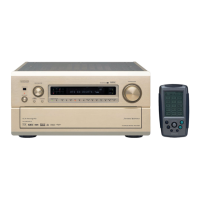LD player, CDV player, etc.
Monitor TV
Video deck 2
Video deck 1
TV or satellite broadcast tuner
Connecting a video disc player (VDP)
Connecting a monitor TV
Connecting the video decks
Connecting a TV/DBS tuner
VDP
• Connect the video disc player’s S-Video output jack to the
S-VIDEO VDP IN jack using an S-Video connection cord.
• A DVD player can be connected to the DVD jacks in the
same way.
• It is also possible to connect a video disc player, DVD player,
video camcorder, game machine, etc., to the V.AUX jacks.
MONITOR OUT
• Connect the TV’s or DBS tuner’s S video input (S-VIDEO
INPUT) to the MONITOR OUT-1 jack using a S
jack connection cord.
• The monitor TV can also be connected in the same way to
the S-VIDEO MONITOR OUT-2 jack.
S-VIDEO
• Connect the TV’s or DBS tuner’s S video output
jack (S-VIDEO OUTPUT) to the
TV/DBS IN jack using an S jack connection
cord.
S-VIDEO
• Connect the video deck’s S output jack (S-OUT) to the VCR-1 IN
jack and the video deck’s S input jack (S-IN) to the VCR-1 OUT jack
using S jack connection cords.
• Connect the video deck’s S output jack (S-OUT) to the VCR-2 IN
jack and the video deck’s S input jack (S-IN) to the VCR-2 OUT jack
using S jack connection cords.
Connect the third video deck to the VCR-3 jacks in the same way.
S-VIDEO
S-VIDEO
S-VIDEO
S-VIDEO
Connect the components’ audio inputs and outputs as described on page 5.
NOTES:
• When the S-Video jacks are used for connection to a player, we recommend also using the S-Video jacks
for connections with the TV monitor.
Depending on the S-Video input, the quality of the picture may be reduced when signals are output from
the video monitor output jacks (yellow).
• The MONITOR OUT-2 output switches together with the input function selected with the REC/M-ZONE2
button. To use as the monitor output, set “SOURCE” as the REC/M-ZONE2 input function. At this time,
the on-screen display signals are output from the video signal MONITOR OUT-2 (yellow) or S-Video signal
MONITOR OUT-2 jack.
Connecting a video component equipped with S-Video jacks
• When making connections, also refer to the operating instructions of the other components.
• A note on the S input jacks
The input selectors for the S inputs and pin jack inputs work in conjunction with each other.
• Precaution when using S-jacks
This unit’s S-jacks (input and output) and video pin jacks (input and output) have independent circuit structures,
so that video signals input from the S-jacks are only output from the S-jack outputs and video signals input
from the pin jacks are only output from the pin jack outputs.
When connecting this unit with equipment that is equipped with S-jacks, keep the above point in mind and
make connections according to the equipment’s instruction manuals.
For a description of the MONITOR OUT terminal, see the page on “Connecting a Video Component Equipped
with Color Difference”.
DVD player
Monitor TV
Connecting a DVD player
Connecting a monitor TV
DVD IN jacks
• Connect the DVD player’s color difference (component)
video output jacks (COMPONENT VIDEO OUTPUT) to the
COMPONENT DVD IN jack using 75 Ω/ ohms coaxial video pin-
plug cords.
• In the same way, another video source with component
video outputs such as a DTV/DBS tuner, etc., can be connected
to the TV/DBS color difference (component) video jacks.
MONITOR OUT jack
• Connect the TV’s color difference (component) video
input jacks (COMPONENT VIDEO INPUT) to the
COMPONENT MONITOR OUT jack using 75 Ω/ohms
coaxial video pin-plug cords.
• The color difference input jacks may be indicated differently on
some TVs, monitors or video components (“PR, PB and Y”, “R-
Y, B-Y and Y”, “CR, CB and Y”, etc.). For details, carefully read
the operating instructions included with the TV or other
component.
Connecting a Video Component Equipped with Color Difference (Component -
Y, P
R
/C
R
, P
B
/C
B
) Video Jacks (DVD Player)
• When making connections, also refer to the operating instructions of the other components.
• The signals input to the color difference (component) video jacks are not output from the VIDEO output jack
(yellow) or the S-Video output jack.
• Some video sources with component video outputs are labeled Y, P
B, PR, or Y, CB, CR, or Y, R-Y, B-Y. These
terms all refer to component video color difference output.
MONITOR OUT jacks
The AVC-A1SR is equipped with a function for up-converting video signals.
Because of this, the AVC-A1SR’s MONITOR OUT jack can be connected to the monitor (TV) with a single cable
offering a higher quality connection, regardless of how the player and the AVC-A1SR’s video input jacks are
connected.
Generally speaking, connections using the component video jacks offer the highest quality playback, followed
by connections using the S-Video jacks, then connections using the regular video jacks (yellow).
If the AVC-A1SR’s MONITOR OUT jack is not connected to the monitor (TV) using the component video
jacks, connect the player to the AVC-A1SR’s video input jacks using either the video jacks (yellow) or the S-
Video jacks. The video signals will not be output if the player and the AVC-A1SR are only connected with the
component video jacks.

